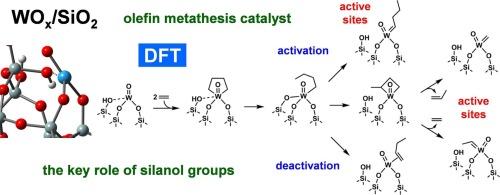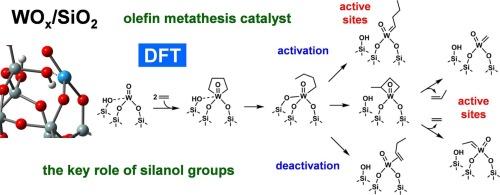钨环戊烷在WOx/SiO2催化剂中的转化:生成烯烃转化活性位点的不同途径
IF 6.5
1区 化学
Q2 CHEMISTRY, PHYSICAL
引用次数: 0
摘要
在大规模烯烃分解工业用WOx/SiO2催化剂中,烯烃和W(IV)氧化物可以形成表面钨环戊烷。在这项工作中,密度泛函理论(DFT)研究了各种实验观察到的硅负载的未取代钨环戊烷物种的转化,主要导致烯烃复分解活性位点的形成。结果表明,方锥型钨环戊烷通过1,4-氢转移转化为W(VI)丁基二烯,比通过W(VI)丁基氢化物中间体进行环收缩转化为α-甲基取代的钨环丁烷,在动力学上更有利。对于具有三角双锥体几何结构的钨环戊烷,环收缩也可以在一个步骤中发生。还研究了乙烯插入α-甲基取代钨环丁烷的次级W-C键,得到γ-甲基取代钨环己烷。如果在金属位附近加入硅烷基,则钨环戊烷转化的激活势垒可降低约50 kJ mol−1。首先形成W(VI)丁基物种,然后与单W(IV)物种一起转化为W(VI)丁基物种、α-甲基取代的钨环丁烷或1-丁烯。提出的硅醇辅助表面钨环戊烷的转化产生烯烃复分解活性位点可能与其他报道的涉及硅醇基团的活化机制竞争。本文章由计算机程序翻译,如有差异,请以英文原文为准。


Transformations of tungstacyclopentane species in a WOx/SiO2 catalyst: Different pathways generating olefin metathesis active sites
Surface tungstacyclopentane species can be formed from alkenes and W(IV) oxide species in the industrial WOx/SiO2 catalyst for large scale olefin metathesis. In this work, density functional theory (DFT) studies of various experimentally observed transformations of silica-supported unsubstituted tungstacyclopentane species, leading mainly to the formation of olefin metathesis active sites, have been performed. It is shown that the conversion of square pyramidal tungstacyclopentane to W(VI) butylidene species via 1,4-hydrogen transfer is slightly more kinetically favored than the ring contraction to α-methyl-substituted tungstacyclobutane through W(VI) butenyl hydride intermediate. In the case of tungstacyclopentane species with the trigonal bipyramidal geometry, the ring contraction can also occur in a single step. Ethene insertion into the secondary W-C bond of the α-methyl-substituted tungstacyclobutane, giving γ-methyl-substituted tungstacyclohexane species, has also been examined. The activation barriers of the tungstacyclopentane transformations can be reduced by about 50 kJ mol−1 if a surface silanol group adjacent to the metal site takes part. Initially, W(VI) butyl species are formed, which can then convert to W(VI) butylidene species, α-methyl-substituted tungstacyclobutane or 1-butene together with the monooxo W(IV) species. The proposed silanol-assisted transformations of surface tungstacyclopentane species yielding olefin metathesis active sites may compete with other reported activation mechanisms involving a silanol group.
求助全文
通过发布文献求助,成功后即可免费获取论文全文。
去求助
来源期刊

Journal of Catalysis
工程技术-工程:化工
CiteScore
12.30
自引率
5.50%
发文量
447
审稿时长
31 days
期刊介绍:
The Journal of Catalysis publishes scholarly articles on both heterogeneous and homogeneous catalysis, covering a wide range of chemical transformations. These include various types of catalysis, such as those mediated by photons, plasmons, and electrons. The focus of the studies is to understand the relationship between catalytic function and the underlying chemical properties of surfaces and metal complexes.
The articles in the journal offer innovative concepts and explore the synthesis and kinetics of inorganic solids and homogeneous complexes. Furthermore, they discuss spectroscopic techniques for characterizing catalysts, investigate the interaction of probes and reacting species with catalysts, and employ theoretical methods.
The research presented in the journal should have direct relevance to the field of catalytic processes, addressing either fundamental aspects or applications of catalysis.
 求助内容:
求助内容: 应助结果提醒方式:
应助结果提醒方式:


